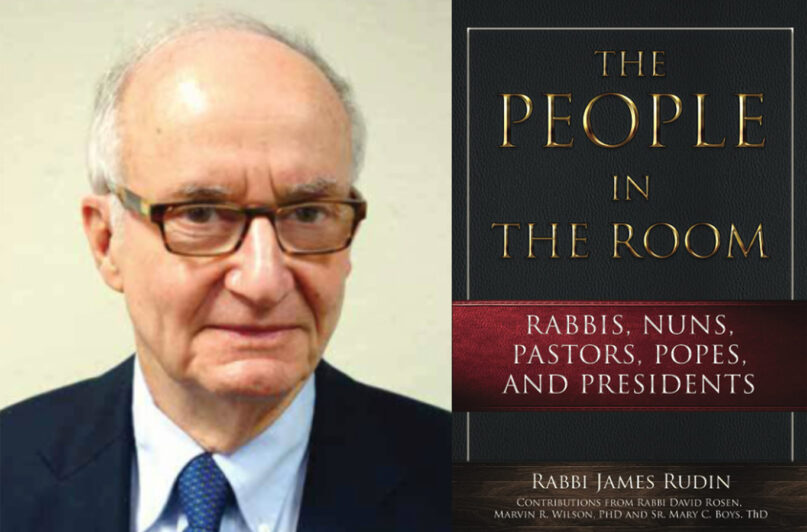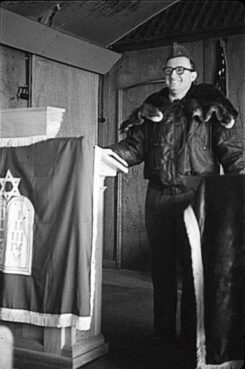Rabbi James Rudin’s memoir recounts the interfaith movement’s hits and misses
In the book, 'The People in the Room: Rabbis, Nuns, Pastors, Popes, and Presidents,' Rudin writes about his favorite collaborators, the challenges of cultivating pluralism and the future of interfaith relations.

(RNS) — Rabbi James Rudin had a front-row seat to all the major developments in Jewish-Christian relations in the second half of the 20th century.
Probably no other rabbi has traveled as widely or met with as many global religious leaders as Rudin, who for 32 years worked at the American Jewish Committee, retiring as its national interreligious affairs director in 2000.
At 87, he’s now written a memoir chronicling his efforts to improve Jewish-Christian ties in the wake of the Holocaust and give Jews a measure of dignity and respect they were often denied.
Rudin’s book, “The People in the Room: Rabbis, Nuns, Pastors, Popes, and Presidents,” tells of his many travels — 42 times across the Atlantic — and his meetings with popes, presidents, Protestant denominational leaders and world-famous evangelists.

Rabbi James Rudin as a U.S. Air Force chaplain at the Iwakuni Marine Corps Air Facility in Japan in 1962. Photo courtesy James Rudin
Rudin’s personal biography before joining the AJC helped. As he writes in the first part of the book, he grew up in Alexandria, Virginia, among Southern Baptists. After finishing rabbinical school, he served for several years as an Air Force chaplain stationed in Japan and Korea. And then, while serving an Illinois congregation, he did graduate work in history at the University of Illinois.
RELATED: Despite 2022’s cluster of religious holidays, multifaith understanding slow to evolve
In addition to possessing a curious mind eager to learn about other religions and make friends across the faith divide, he is also a writer, contributing hundreds of columns over the years to Religion News Service, among other outlets.
RNS spoke to Rudin from his home in Florida about his favorite collaborators in his interfaith work, the challenges, even today, of cultivating pluralism and the future of interfaith relations. The interview has been edited for length and clarity.
You devote a full chapter to the late New York Cardinal John O’Connor and another to a Catholic Sister Ann Gillen. Are Catholics the group you had the most success with?
No. We just hit it off very well. I came on board the AJC in 1968. That was three years after the conclusion of the Second Vatican Council. Because of the excitement and the breakthrough of “Nostra Aetate” (the document that transformed the church’s approach to Judaism), there was a lot of energy around Catholic-Jewish relations. Also, Jews historically had more contact with Catholics than any other group. Cardinal O’Connor, of blessed memory, was a friend, a colleague. In private we called each other by our first names.
But growing up in Alexandria, Virginia, I also had an understanding of Southern Baptists. I knew these folks. I went to school with them. I went to their revivals. It helped me in relating to them.
Each December in the area I grew up there was a huge Christmas decoration contest. It was very important to these families who won the contest. They had a very divisive decision one December and it looked like it would be the end of the contest. They came to my father and asked him if he and my family could be the judges because we would be totally impartial, which we were. So for several years my late brother and father and I trudged round in the snow to judge which house had the best Christmas decorations. Our judgments were upheld because we were totally impartial. I don’t think too many rabbis had that experience.
One of the evangelicals you grew to respect is Billy Graham. How did your views of him change?
I met with him during his last crusade when he came to New York in 2005. In a private conversation he said that he would go on his hands and knees and beg forgiveness from the Jewish community for the things he said and agreed with in 1972 in his White House meetings with President Richard Nixon, which were full of antisemitism. He regretted it. He apologized.
A lot of the work you did abroad was trying to explain to Christians how their own Scriptures often cast Jews as Christ-killers. You devote a chapter to Oberammergau, a town in the Bavarian Alps famous for its Passion plays, which in years past were virulently anti-Jewish. How hard was it?
When I went there I was fully aware that we were trying to overcome antisemitism. Europe was a haunted continent because of what happened there. I went to Germany many times. I was one of the first interreligious American Jewish leaders to go to Poland in 1989 to build positive Christian-Jewish relations. But it was also very personal. My own family — my uncles, my cousins — were involved in battles with the Germans in World War II. I got a tour of Auschwitz by a wonderful Polish Catholic priest. It made the work sacred to me. But it was also very difficult.
The U.S. is having a hard time with pluralism these days. But you write about a battle back in the late 1980s over the design of a chapel at Camp David in which the committee you served on wanted stained glass windows with Christian symbols. How’d you get them to change their minds?
The committee felt they were not creating an interreligious chapel for a presidential retreat but a Christian church. I was told again and again, America is a Christian country. But the Founding Fathers had every opportunity to put Jesus into the Constitution or the Declaration of Independence. It’s not an accident that it isn’t there. Ironically, Camp David is a place 99% of Americans will never visit. It’s a secluded presidential retreat. But that’s where it played out at the highest level. I had to deal with it diplomatically. It was a time for me to not only quote Jefferson and Madison but to point out that we were doing this for history. Once you put this chapel there, international visitors would come there of all religions and no religion. It was a very important and symbolic moment for me. It was one of my proudest moments. I’m not sure I would be as successful today persuading people to understand American history.
What do you think of interreligious work today when the authority of religious leadership is being challenged everywhere?
In the sexual abuse scandal we have the perfect trifecta. We’ve had the Roman Catholic sexual abuse scandal. Earlier this year we had sexual abuse scandal in my movement, the Reform (Jewish) movement. Now we have it in the largest Protestant denomination. Is it any wonder respect and commitment to various religious leaders are under attack? Religion is radioactive. Sometimes it can be very helpful; sometimes highly destructive. You have to handle it with great care. We need fewer declarations, fewer statements, fewer proclamations. We need less wholesale religion and more retail. I’m advocating for lay-led, small groups that tackle problems in communities on an interreligious basis. That’s the future; small pockets of religious energy.
In the U.S., all religions are represented. Nobody’s getting out of the boat. It’s a necessity that we have interreligious cooperation and bridges of human solidarity.
No comments:
Post a Comment